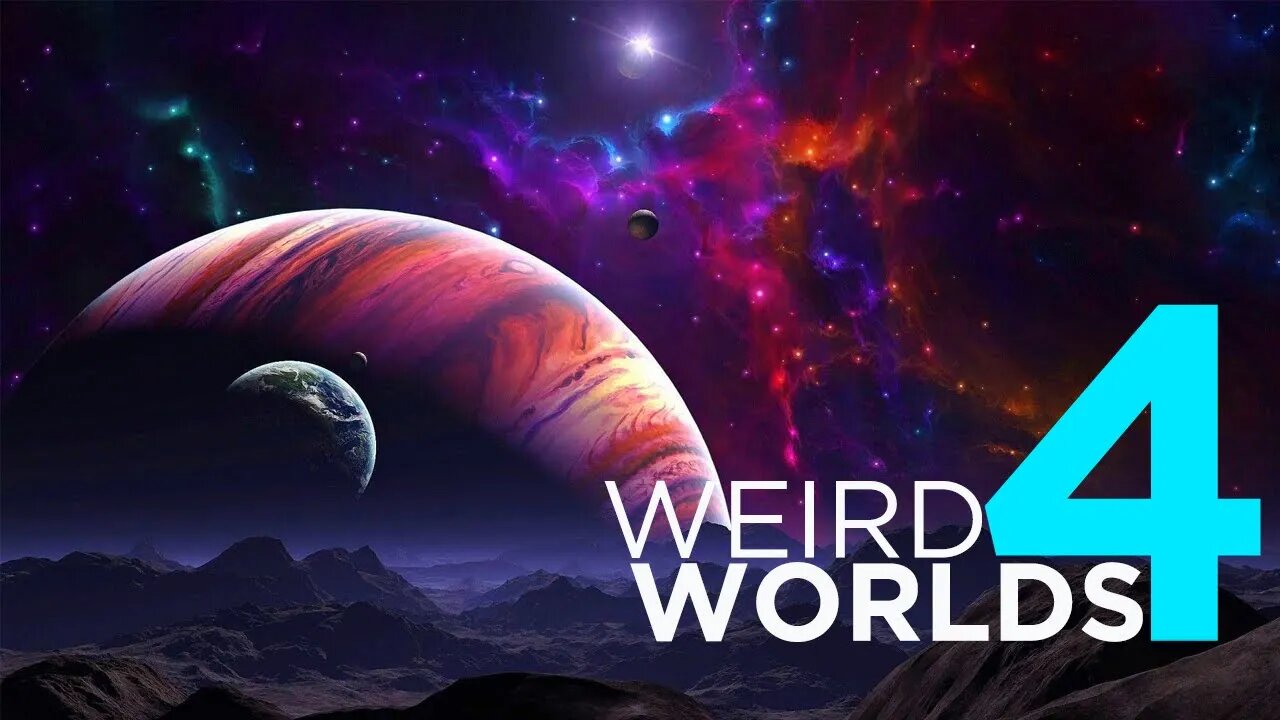Premium Only Content

WEIRD WORLDS 4
Presenting Weird Worlds 4. This is 4th of the series "Weird Words". We will explore six more planets which are once again bizarre and mind boggling
Tres - 2b – The planet that is Darker Than Coal
The planet has been identified in 2011 as the darkest known exoplanet, reflecting less than 1% of any light that hits it (less than coal, for example). And the light reflected is dimly red which gives the planet an evil red color.
Kepler-78b - A Lava Planet
Kepler-78b is similar to our planet Earth. This exoplanet is in the Cygnus constellation. The strangest thing about it, though, is how close it is to its host star: it is only 550,000 miles (885,139 kilometers) away. It is 40 times closer to its star than Mercury is to Sun and its temperature is estimated to be around 2030 °C (3680 °F).
According to Francesco Pepe, one of the astronomers involved with the discovery, the planet may be Earth-sized but "it can be imagined like a lava planet rather than an Earth-like planet."
TOI 849 b – a world stripped bare
Discovered in 2020 by NASA’s Transiting Exoplanet Survey Satellite (TESS), it’s no fun at all on TOI 849 b. This exoplanet orbits so tightly to its star that a year passes in 18 hours. Don’t bother with constant birthday parties though, as there’s no atmosphere and the 1530°C heat would melt the cake.
What makes TOI 849 b particularly weird though is its strangely hybrid nature. While it’s around the size of gas giant Neptune, it’s dense and rocky not gaseous – in fact, it’s the largest rocky world yet discovered, 40 times as massive as Earth. It may even be the first Chthonian planet to be detected: the exposed remnant core of a gas giant that has had its atmosphere blasted away.
Rogue worlds: exoplanets on the loose
Many exoplanets may be scary and inhospitable, and they may come in different sizes, colours and densities, but at least they all reliably do one thing: orbit a star. Or do they? While most planets are locked in orbit around their sun, some worlds are actually roaming the galaxy untethered. With no parent star to light and warm them, life is dark and cold on these nomads adrift in the vastness of space.
Catching sight of these hard-to-detect ‘rogue planets’ will be one of the tasks for NASA’s Nancy Grace Roman Space Telescope, coming online around 2025. One such planet is OT44, located 550 lightyears away in the constellation Chamaeleon. This cosmic wanderer is eleven times more massive than Jupiter and thought to have a circumstellar disc of dust, rock and ice. The recently identified OGLE-2016-BLG-1928 is another. Likely smaller than Earth, it’s one of the lowest-mass objects ever found using microlensing techniques.
KELT-9b – the hottest exoplanet
Ultra-hot Jupiter-type exoplanet KELT-9b is so scorching that it’s even hotter than many stars. It orbits so close to its sun that its surface sizzles at 4,300C – so hot that it has atomic iron and titanium in its atmosphere – and a year lasts less than a day and a half.
Using data from the Spitzer Space Telescope, researchers have found that the extreme temperatures on the planet’s dayside cause molecules of hydrogen gas to tear apart, only to recombine when they flow to the relatively cooler eternal nightside, before being torn apart once more when they move back into the furnace.
K2-18b – where a swim may vaporize you
K2-18b, twice the radius and eight times the mass of Earth, has been a top contender for an Earth-like planet for years, so there was huge excitement when it was announced in 2019 that water had been discovered in K2-18b’s atmosphere. For the first time, we’d found a rocky planet orbiting in the habitable zone of its star, in which liquid water could potentially pool on the surface.
Before we could dream of luxuriating in exotic oceans, though, came the view that K2-18b may be more like the far less friendly mini-Neptunes – planets with a thick hydrogen atmosphere, a watery layer and a rocky iron core, where temperatures and pressures are far too high to support life.
New research suggests K2-18b could hover in a third zone: planets that looks like a gaseous mini-Neptune but are actually rocky planets covered in superheated, super-compressed seas, where the water exists somewhere on the threshold between liquid and gas, and is topped by a steamy water vapour atmosphere. Sadly, we have to put our swimming costumes away for now.
-
 2:08:15
2:08:15
Adam Carolla
2 days ago $1.12 earnedDolph Lundgren on Beating Cancer, Sahil Bloom Talks 5 Types of Wealth & Gen-Z’s Minecraft Madness
3.38K5 -
 LIVE
LIVE
Alex Zedra
2 hours agoLIVE! Scary Games Girls Night
718 watching -
 LIVE
LIVE
Drew Hernandez
9 hours agoKARMELO ANTHONY FAM BUYS NEW CAR, BIG LETICIA IS SHOOK & EL SALVADOR ILLEGAL IS A WIFE BEATER?
2,427 watching -
 LIVE
LIVE
Man in America
8 hours agoTHE GREAT TAKING: They’re Coming for YOUR Assets—the Sinister Plan Exposed w/ James Patrick
980 watching -
 UPCOMING
UPCOMING
Amish Zaku
2 hours agoCall in Creations EP# 10 Featuring GamerGril
13 -
 1:11:52
1:11:52
Omar Elattar
8 hours agoThe Ex-Marine Millionaire: "How I Turned My $26K in Savings to $70M at 35!"
12.4K1 -
 LIVE
LIVE
I_Came_With_Fire_Podcast
11 hours agoChina Trade War | Driving Miss Perry | German Court
144 watching -
 1:37:07
1:37:07
Glenn Greenwald
4 hours agoAre We Moving Towards War With Iran? PLUS: Zaid Jilani on the El Salvador Deportations and Harvard’s Fight Against Trump | SYSTEM UPDATE #440
85.6K41 -

Badlands Media
18 hours agoAltered State S3 Ep. 24: Letitia James Exposed, Harvard's Fall from Grace, and the Woke Hollywood Implosion
31.6K10 -
 LIVE
LIVE
SpartakusLIVE
5 hours agoCustoms w/ Stonemountain64 || Regular WZ DUBS to follow
125 watching